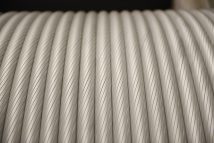The mechanical and physical characteristics of aluminum can be altered and enhanced by using alloys. Zirconium, for instance, is added to make aluminum alloys thermal-resistant. Or in other words, after the alloy is exposed to high temperatures, it will return to its original condition. More specifically, adding Zirconium to aluminum, inhibits recrystallization and allows grain structure to be controlled at elevated temperatures. Zirconium has therefore been instrumental in the development of advanced aluminum overhead conductors that can operate at high temperatures. At the same time, AlZr alloys present an interesting alternative for copper in certain manufacturing industries.
Developing beyond standards
The properties of the different types of AlZr alloy wires are specified in the international IEC62004 standard. The current standard includes a series of different alloys called AT1, AT2, AT3 and AT4, each with their continuous and maximum operating temperature, conductivity, tensile strength and elongation. Lamifil has been producing AlZr alloy wires since 1997. Besides production for use in its advanced overhead conductors, it has delivered tons of AlZr wire rod and drawn wire for other manufacturing industries.
As an aluminum alloy expert, Lamifil has taken the AlZr alloy to the next level. Intensive research and development has resulted in further conductivity improvement of the existing standardized alloys and the development of the brand new and patented AT0 or Softal and AT⅟2 or Semital alloys. These proprietary alloys are unique and allow Lamifil to present an unmatched offering of customized HTLS (High Temperature Low Sag) overhead conductors that match high temperature and high Ice load sag.
Advanced HTLS conductors combining optimal conductivity and sag behavior

Because Lamifil has been able to upgrade the AT1 and AT3 conductivity to minimum 61% IACS, these alloys are as conductive as pure aluminum, but boast far better thermal resistance. So any aluminum steel or ACSR conductor can be replaced with a thermal resistant conductor without losing any of its characteristics. This could be a game changer for grids that want to introduce robustness without any extensive engineering work.
When designing overhead conductors for optimal performance, the choice of alloy strongly depends on the given boundary conditions. Hard aluminum (160-200 MPa and 61% IACS) typically provides a conductor significantly more strength, and improves sag under wind and ice loads. Annealed aluminum (60-80 MPA and 63% IACS), on the other hand, provides higher conductivity and improves sag at higher temperatures.
To solve the ‘high temperature or high load’ dilemma, Lamifil has developed two new alloys. The patented AT0 or Softal alloy has 50% higher tensile strength than annealed aluminum yet with the same 63% IACS conductivity. The AT⅟2 or Semital alloy doubles the tensile strength of annealed aluminium while still maintaining a conductivity of 62% IACS.
The addition of these new alloys to the range of existing standardized alloys, allows overhead conductor manufacturers to take high conductivity as a starting point, while modulating the appropriate tensile strength for an ideal conductor design, combining optimal conductivity with optimal sag behavior.
An alternative for copper wires
AlZr alloys have revolutionized the way modern overhead conductors are being made. Because of their key characteristics – low weight, thermal-resistant, good conductivity – they show potential for applications in many other industries.
As aluminum has only 30% of the weight of copper, combined with 60% of its conductivity, an AlZr alloy could be an advantageous alternative for weight reduction of certain copper-based cables used in the automotive or aerospace industry, among others. Specifically for applications in which wires are only subjected to momentary thermal loads, such as battery cables and small power cables, AlZr could provide a solution with good conductivity saving up to 50% of weight compared to copper.
As a leading producer of AlZr alloy products, Lamifil will continue to put its expertise and research to use and work together with its customers to explore new applications.
Contact us to find out more on the possibilities of the AlZr alloy.
